FRILLED LIZARD
(Frilled Neck Lizard - Frilled Dragon)
By Alexander Keller
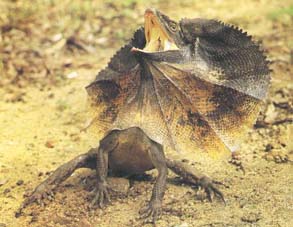 General
General
This sun-loving lizard (Frilled Lizard) is the reptile emblem of
Australia, depicted on our now defunct two-cent coin This reptile is part
of the Dragon family a sub-species of Lizards They are usually active during
the day and move very fast on their two hind legs 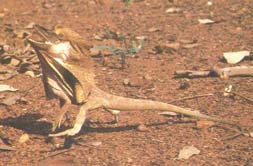
Description
Head and Body Length: to 28cm Total Overall Length: usually 70 cm
but up to 95cm
The color of the lizard matches the land on which it lives, so a
frilled lizard from one region may be brighter than another. The male is
more colourful than the female They are not poisonous or harmful to man
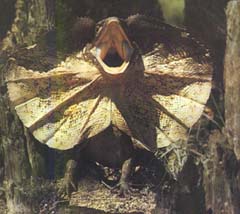 The
"Frill"
The
"Frill"
The frill normally lies in folds around the shoulders and neck and
is "activated" by the lizard when frightened by opening its mouth wide
It is supported by a set of cartilaginous rods connected to the muscles
of the tongue and jaws in such a manner that, when the mouth gapes widely,
the frill is extended, ruff-like around the head (like an umbrella), displaying
a broad, rounded expanse of bright orange and red scales. The frill is
also believed to aid in the regulation of body temperature.
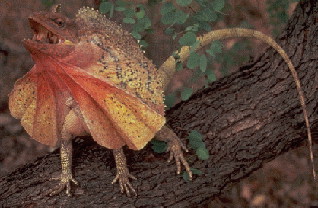
Habitat
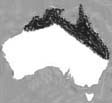 Tropical to warm temperate dry forests, woodland and savanna woodland,
usually with an open shrubby or tussock grass understorey, this being found
in Australia northern Queensland and the Northern Territory
Tropical to warm temperate dry forests, woodland and savanna woodland,
usually with an open shrubby or tussock grass understorey, this being found
in Australia northern Queensland and the Northern Territory
Land clearing is reducing the area where this reptile is found
Defence & Camouflage
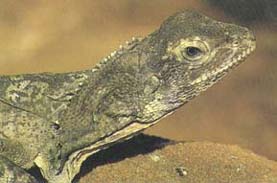 With its frill completely folded back and the head, body and tail touching
the bark the frilled lizard perches on tree trunks, fallen or standing
and with its pattern matching the bark so well, it is a very difficult
animal to see. When approached, it circles around the trunk to the "shadow"
side and "sneaks a peek" at you.
With its frill completely folded back and the head, body and tail touching
the bark the frilled lizard perches on tree trunks, fallen or standing
and with its pattern matching the bark so well, it is a very difficult
animal to see. When approached, it circles around the trunk to the "shadow"
side and "sneaks a peek" at you.
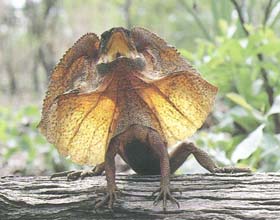
5 step defence plan
1) If it sees danger it slowly cringes
down onto the ground looking like a stout stick, relying on its natural
body colours to act as camouflage
2) If the lizard feels threatened it
will extend its legs and open its mouth widely thus erecting the frill
in a blaze of startling colour.
3) To add to the bluff, it may hiss
and jump towards the threat
4) If the frill and hissing is not
effective the frilled lizard menaces "the threat" by repeatedly lashing
its tail on the ground
5a) The frilled lizard as a last resort
prefers to run rather than fight by making a sudden turn and running off,
on its hind legs, to the nearest tree, which it climbs until out of reach.
5b) But if forced to fight this lizard
can inflict painful bites with its large canine teeth
Its fearsome bluff though is no match for feral cats its biggest
enemy, brought to Australia by "European" settlement.
 Eating
Eating
It eats with its frill back and hunts mostly in the trees for insects
(eg.cicadas) but it also descends to the ground to catch other insects
(including ants, which it eats in great numbers from trails and near the
edges of nests), spiders and even small lizards that venture too close.
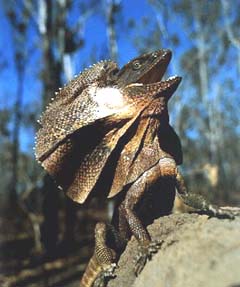 Breeding
Breeding
Matting occurs around September, with the female laying from eight
to 23 eggs per clutch in November. Some females can produce two clutches
of eggs in the one season. The hatchlings start appearing usally in early
February weighing around 3 to 5 grams.






Page Author: Alex Keller
Email Alex Keller
 The
"Frill"
The
"Frill"
 General
General


 Tropical to warm temperate dry forests, woodland and savanna woodland,
usually with an open shrubby or tussock grass understorey, this being found
in Australia northern Queensland and the Northern Territory
Tropical to warm temperate dry forests, woodland and savanna woodland,
usually with an open shrubby or tussock grass understorey, this being found
in Australia northern Queensland and the Northern Territory
 With its frill completely folded back and the head, body and tail touching
the bark the frilled lizard perches on tree trunks, fallen or standing
and with its pattern matching the bark so well, it is a very difficult
animal to see. When approached, it circles around the trunk to the "shadow"
side and "sneaks a peek" at you.
With its frill completely folded back and the head, body and tail touching
the bark the frilled lizard perches on tree trunks, fallen or standing
and with its pattern matching the bark so well, it is a very difficult
animal to see. When approached, it circles around the trunk to the "shadow"
side and "sneaks a peek" at you.

 Eating
Eating
 Breeding
Breeding